How to Create Sales Funnel for Beginners (Digital Marketing)
Creating a sales funnel helps business and marketers to convert their audience into loyal customers. Learning about the sales funnel and creating a sales pipeline is key to successful digital marketing.
A sales funnel maps out the route that potential customers take from their first interaction with your brand all the way through to a finalized purchase.
Constructing this path clearly enables you to,
- Understand and influence consumer behavior at each stage.
- Provide values that will best help your prospects.
- Help guide potential leads towards making a buying decision.
KEY TAKEAWAYS
- Sales funnel is crucial for business and marketers who wants to converting leads into customers.
- Each funnel stage must be optimized for higher conversion rates; TOFU, MOFU and BOFU.
- Digital marketing tools together with AIDA can enhance funnel effectiveness.
What is a Sales Funnel?
A sales funnel represents the customer’s journey from awareness to the final purchase. It’s a series of stages designed to turn prospects into loyal customers, guiding them step by step through a deliberate process.
Creating a highly effective marketing funnel means to provide value at each stage of the process, nurturing your relationship with the customer and help your customer move through that funnel.
A perfect sales funnel have three sales funnel stages:
- Top of the sales funnel (TOFU)
- Middle of the sales funnel (MOFU)
- Bottom of the sales funnel (BOFU)
Three Sales Funnel Stages: Building a Effective Sales Funnel Process
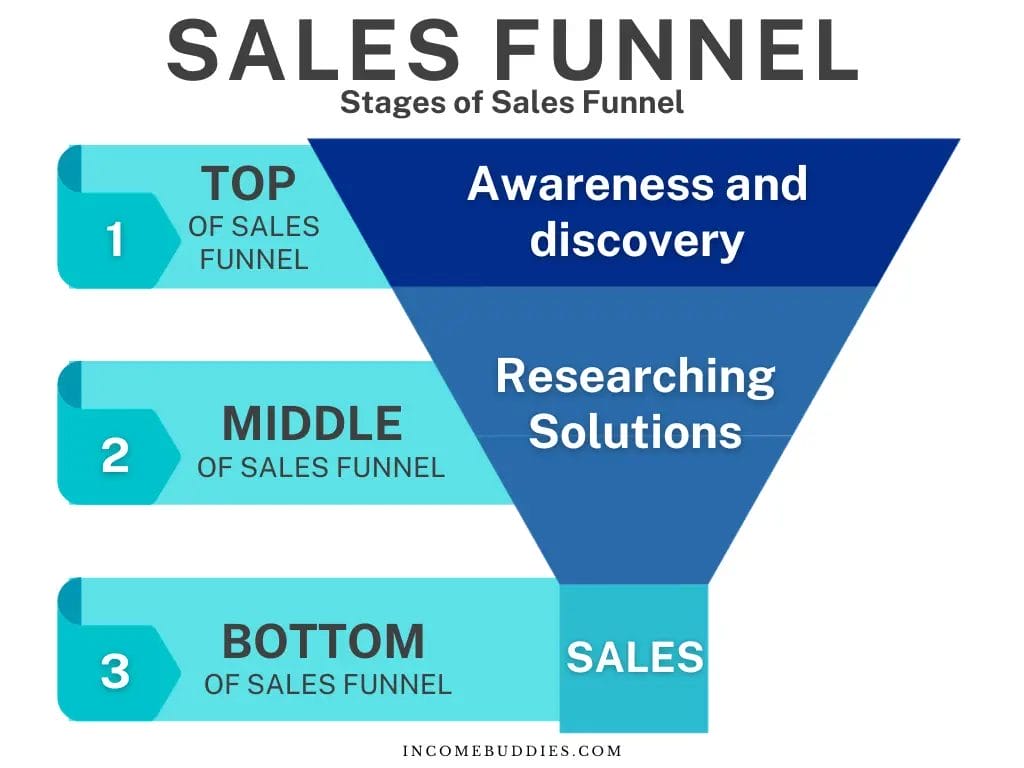
Mapping a sales funnel clarifies your strategy for guiding potential customers from their initial engagement with your brand to a successful purchase.
By understanding these stages, you equip your sales team with critical insights to navigate customer needs, address challenges effectively, and enhance the overall conversion process.
- Top of Funnel: The sales funnel begins from a large number of potential customers.
- Middle of Funnel: As these customers goes through the sales funnel process, it filter out those who are not your target customer.
- Bottom of Funnel: Focus your marketing efforts at the bottom of the funnel, these are group of high buying intent individuals who are most likely going to convert and make a purchase.
Let’s take a look at each of the stage of the sales funnel in detail.
1. Top of the Sales Funnel (TOFU): Awareness and Discovery
At the awareness stage, you are just a name amongst many to potential customers.
They are experiencing a challenge or question and begin to seek answers, chances are they stumble upon your content.
You goal here is to make your brand known to your audience. You want to emerge as a trustworthy source of information.
- Create social media post and get more followers.
- Create targeted blog post about an industry benchmark.
- Create an engaging video that addresses common problems.
Here, you aim to transition untouched prospects into leads by demonstrating that you understand and can solve their initial queries.
2. Middle of the Sales Funnel (MOFU): Researching Solutions
Once you’ve captured initial interest and prospects recognize their problem, they enter the research phase, hunting for specific solutions.
At this juncture, the dialogue between you and potential customers is vital: you provide comprehensive guides and compare options to confirm your ability to meet their unique needs.
- Create informative newsletter and nurture your audience.
- Create helpful guides that educate your audience to make better decisions.
- Create free resources and even an eBook that provide value for your audience.
Middle of the funnel is where you put your effort in refining your lead pool, separating the qualified from the merely curious.
Want some sales funnel examples?
The article you are reading right now is consider a middle stage of the sales funnel where I am providing value and nurturing “you” who are my audience.
Giving you as much value as possible, building that trust between us as buddies who is there to support each other.
If I am going to promote any service or products, you will most likely be more willing to try because you trust me and we’ve build a rapport where you know my opinions are always 100% honest and genuine.
The article you are reading right now will help educate you to make better decisions.
3. Bottom Of The Sales Funnel (BOFU): Making an Educated Purchase Decision
By the time leads reach the bottom of the funnel, your prospects are well-informed and ready to choose a vendor.
They now compare specific features, warranties, or terms that your company presents against your competition.
- Offer content like detailed sales page with FAQs
- Create webinars with product demos
- Create resources on features comparisons
Your goal is to guide your leads through the proposal, negotiation, and to the point where they’re ready to make a confident purchase decision—turning qualified leads into customers.
Similar to what I’ve done in my sales page promoting my book “Start Small, Dream Big”, a book on overcoming procrastination and helping you reach your dream goals.
The sales page of the book will be more effective to those audience who are at the bottom of the funnel, prospects who are really serious about overcome procrastination.
And since I am writing about sales funnel, do check out my book, “Start Small, Dream Big“, I am sure you’ll benefit from reading it!
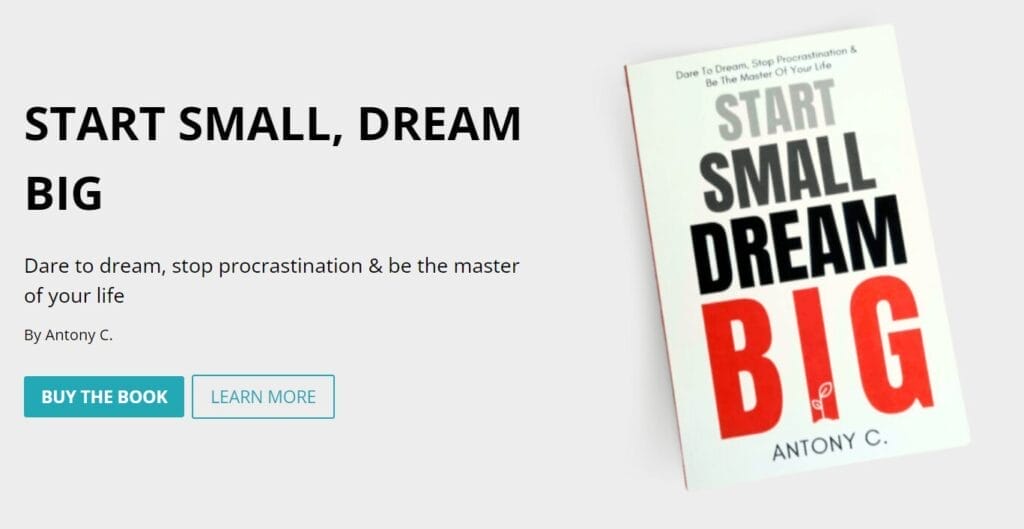
See what I’ve just did?
That’s a call-to-action for prospect who are at the middle or bottom of the funnel.
Benefits of Sales Funnels in Digital Marketing
Creating a sales funnel is crucial, as it guides potential customers on a journey towards making a purchase. Well-constructed sales funnels provide a framework to tailor marketing strategies and optimize them for better conversion rates.
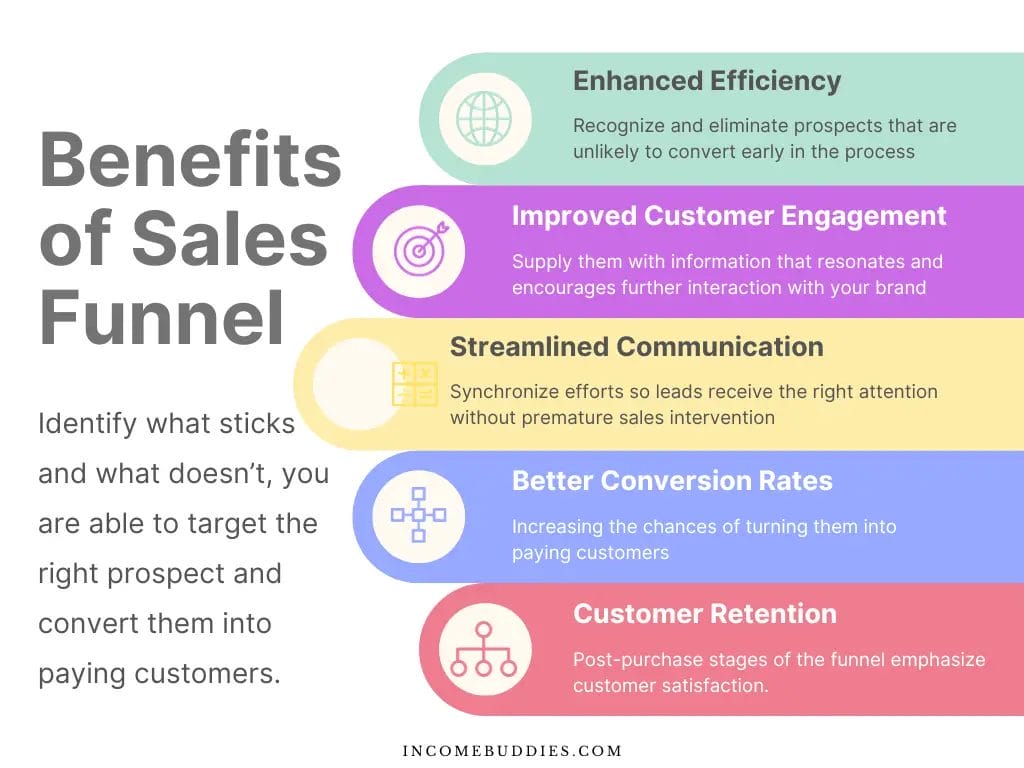
Benefit 1. Enhanced Efficiency
Sales funnels allow you to recognize and eliminate prospects that are unlikely to convert early in the process. This results in a more efficient use of your time and marketing resources.
Benefit 2. Improved Customer Engagement
Funnels enable you to deliver timely and relevant content. By understanding where your customers are in their buying journey, you can supply them with information that resonates and encourages further interaction with your brand.
Benefit 3. Streamlined Communication
Sales funnels facilitate smoother interactions between your sales and marketing teams. They help synchronize efforts so leads receive the right attention without premature sales intervention.
Benefit 4. Better Conversion Rates
These funnels help in nurturing leads systematically, increasing the chances of turning them into paying customers.
Benefit 5. Customer Retention
Post-purchase stages of the funnel emphasize customer satisfaction, which can foster loyalty and repeat business.
How Distinct Stages of Sales Funnel Benefit Your business?
Sales funnels are vital in digital marketing, offering a strategic advantage for guiding customers to make informed decisions and enhancing the shopping experience.
Top of Sales Funnel
- Awareness: Capture the attention of a broad audience.
- Interest: Hook the intrigued with valuable insights about your brand.
Middle of Sales Funnel
- Evaluation: Provide answers and comparisons to educate the well-informed.
Bottom of Sales Funnel
- Decision: Address final concerns to nudge the near-convinced.
- Purchase: Celebrate as prospects transform into customers.
- Retention: Encourage customers to return and stay loyal.
How to Create a Sales Funnel For Beginner?

A good sales funnel is not just a pathway to purchase but a means to build a long-standing customer relationship; it’s a reflection of the consumer’s journey, tailored to nurture your prospects with the right information and engagements at the right time.
To build a successful sales funnel that align your marketing and sales, you can optimizing each stage of the funnel from awareness to purchase, maximizing your conversion rate and boosting your marketing efficiency.
Here’s a step by step process to create a proper sales funnel to improve sales and conversion.
Step 1. Planning Your Sales Funnel Strategy
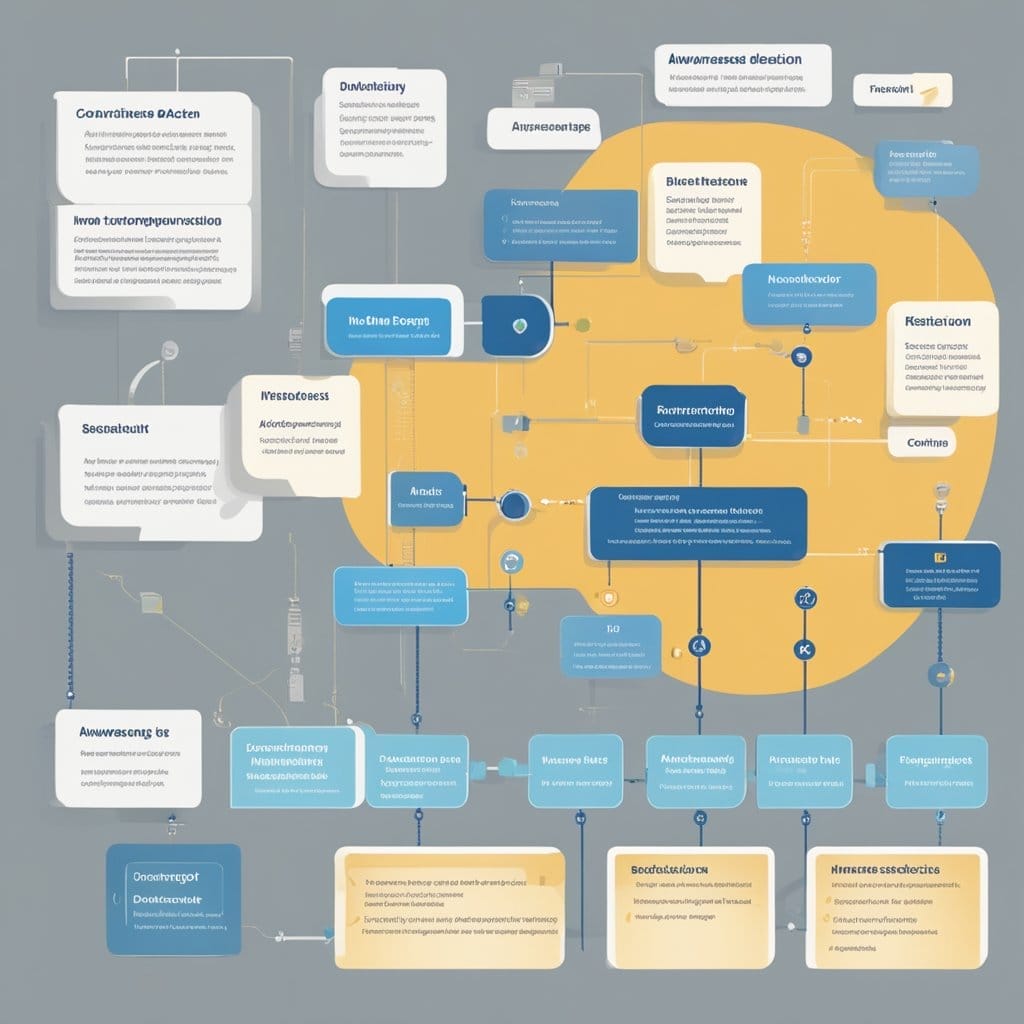
Crafting an effective sales funnel is crucial for turning potential customers into buyers.
Identifying Your Target Audience
Identify your audience with precision. Learn their behaviors, needs, and pain points to tailor your sales strategy.
Demographics, interests, and purchasing habits should guide your messaging for various sales funnel stages.
Setting Clear Objectives for Each Funnel Stage
Each stage of your funnel strategy needs a clear goal.
Whether it’s awareness, interest, decision, or action, define what success looks like at each step.
This approach ensures your sales funnel strategy effectively guides prospects towards a purchase, optimizing the funnel for your business.
Step 2. Creating a Blueprint for Your Sales Funnel

Before diving into sales funnel creation, understand your audience. Research their needs, challenges, and behavior.
Knowing your audience is crucial to design a funnel that truly resonates with potential customers.
Map Out Your Customer’s Journey
Think of this as the backbone of your funnel. Here’s a basic journey flow to get started:
- Awareness: Your prospect learns about your product or service.
- Interest: The prospect shows interest by engaging with your content.
- Decision: They’re considering purchasing and might need more information.
- Action: The prospect converts and makes a purchase.
This is the AIDA framework which tells you about how a prospect journey from getting to know about your product all the way to taking some form of action.
You can take this framework and incorporate it to the various stages of the sales funnel.
Combine AIDA into Stages Of Your Funnel
Put the AIDA framework into good use by adding the various concept into each stages of the funnel so that you can guide your prospects down the funnel to making the sale.
- Top of Funnel (ToFu): Generate awareness with content like blogs and social media posts.
- Middle of Funnel (MoFu): Build interest and evaluate decisions with ebooks, webinars, and newsletters.
- Bottom of Funnel (BoFu): Convert with free trials, demos, and sales calls.
Leverage Tools
Using a CRM tool can be beneficial to track leads and manage interactions. Automation plays a key role in ensuring consistent and timely follow-up.
Remember, each part of the funnel must align with the others. The content and strategies should flow seamlessly, nudging the prospect towards conversion.
Set Your Key Performance Indicator (KPI)
Finally, set clear goals and KPIs for each stage of the funnel.
I set my own KPI and to do so, I usually use the SMART methodology, which stands for Specific, Measurable, Attainable, Relevant and Time-bound.
For example, the KPI I can set for my book I am promoting using the SMART methodology is:
- Specific: I’d like to provide massive value to my audience by writing articles that is both insightful and genuine.
- Measurable: I will write at least 1 in-depth and highly researched article per week on IncomeBuddies.com.
- Attainable: My passion is about transforming life, and I’ve already build a targeted audience based that are looking to take control of their life.
- Relevant: Article I write will be related to my book which offers insights that will help my target audience to be in control of their future by overcoming procrastination and achieving their goals.
- Time-bound: By end of the next 3 months I will like to have 10% more reviews from people who are reading my book “Start Small, Dream Big”.
For your KPI, you need to ensure every action is measurable. This way, you can track success and make data-driven decisions.
Your blueprint is your guide. Stick to it, refine as necessary, and watch your digital marketing efforts yield results.
Step 3. Building the Foundation of Your Sales Funnel
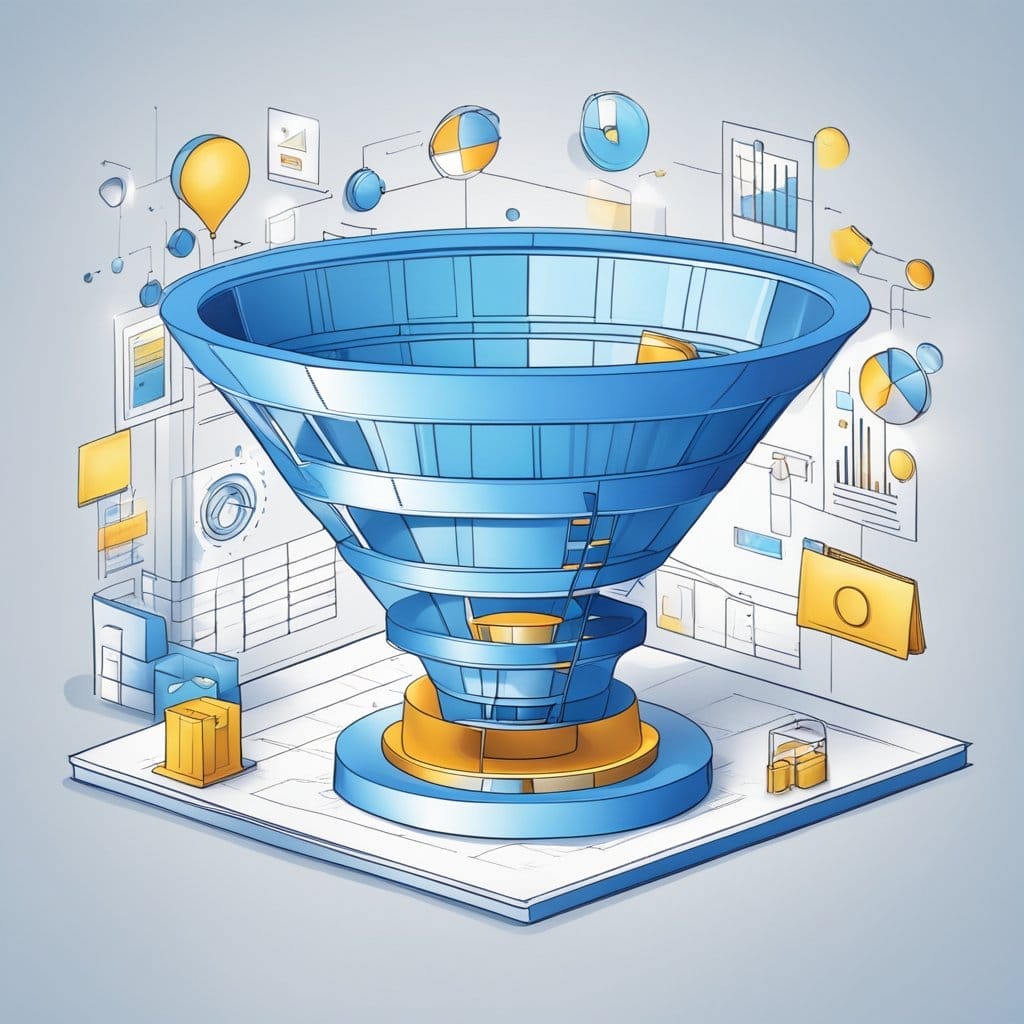
Creating a robust sales funnel is pivotal to guide potential customers through the journey from awareness to purchase. Each stage of the sales funnel serves a distinct purpose in nurturing customer relationships.
Generating Leads at the Top of the Funnel
To start building your sales funnel, focus on generating leads. Cast a wide net with compelling content and optimized landing pages to attract a diverse audience. Use:
- Blog posts
- Social media campaigns
- eBooks and guides
Incorporate calls-to-action to convert website visitors into leads.
Nurturing Prospects in the Middle Stage
Once leads enter the middle of the funnel, it’s time to nurture those relationships. Keep them engaged with:
- Targeted email campaigns
- Webinars
- Case studies
Here, you’ll educate your prospects about your offerings and prove your value.
Facilitating Decisions at the Bottom Stage
At the bottom of the funnel, your leads are on the verge of decision-making. Provide them with:
- Personalized consultations
- Free trials or demos
- Comparison sheets
Offer clear next steps to make the purchasing process straightforward and irresistible.
Step 4. Creating and Optimizing Funnel Content
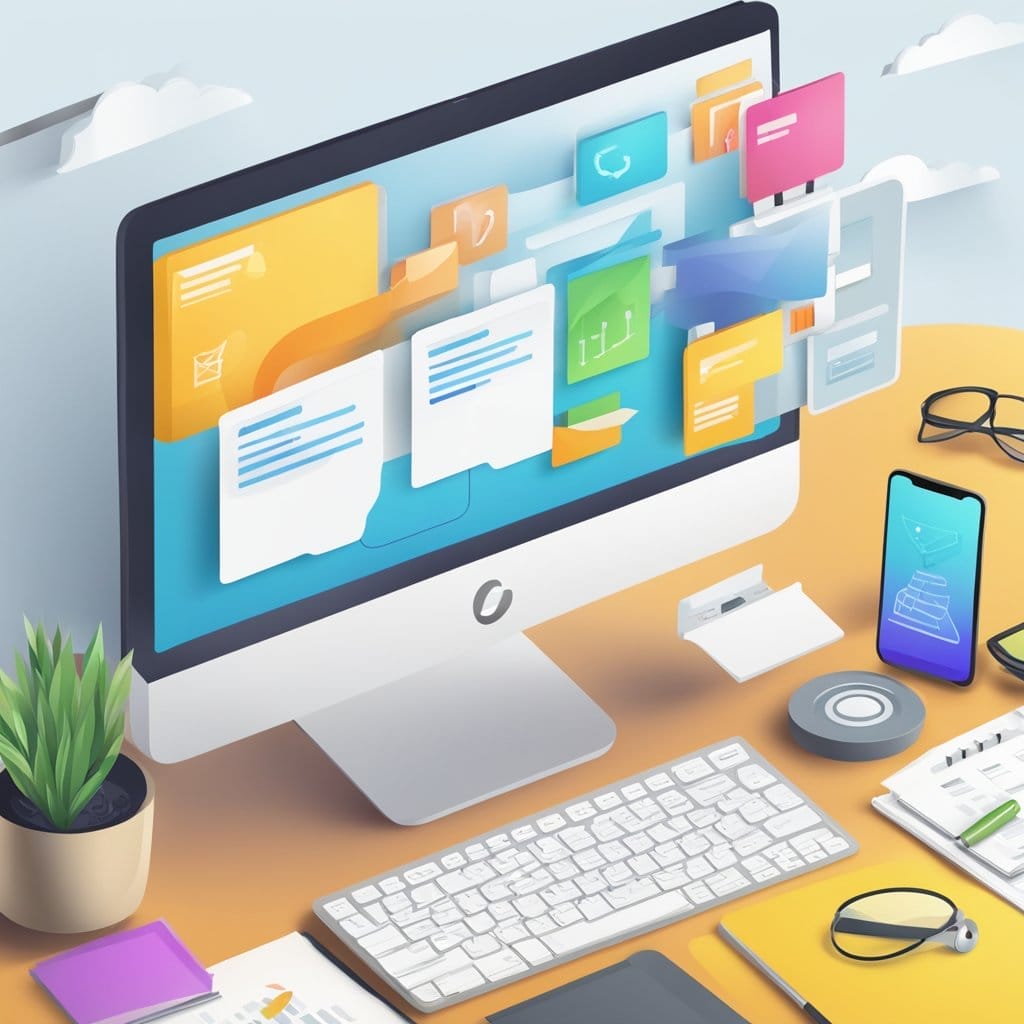
To build a sales funnel that converts, focus on crafting compelling blog posts and sales pages, enhancing user experience, and incorporating effective lead magnets.
Developing Effective Blog Posts and Sales Pages
Your blog posts and sales pages are pivotal for nurturing leads.
Start by understanding your audience and tailoring content to solve their problems with actionable insights.
- Use powerful headlines and ensure that your blog posts provide value
- Create your sales pages that is precise with clear calls-to-action (CTAs) that guide users to the next step.
Remember to optimize your funnel with SEO-friendly techniques, like targeting specific keywords and incorporating meta descriptions to drive traffic and boost visibility.
Designing a User-Friendly Experience
A seamless navigation path is crucial for optimizing your sales funnel.
- Ensure your content layout is intuitive, with user-friendly interfaces that encourage interaction.
- Your text should be easy to read; opt for bulleted lists, subheadings, and short paragraphs.
- Test loading speeds and mobile responsiveness, as these factors significantly affect user engagement and retention.
Improve your funnel by analyzing user behavior data to make informed adjustments, serving to enhance your marketing and sales efforts.
Leveraging Free Trials and Lead Magnets
Free trials and lead magnets are your bait for potential customers, granting them a taste of what you offer.
- Free Trials: Offer free trials to showcase the value of your product or service, compelling users to make a purchase.
- Lead Magnets: Effective lead magnets, such as e-books, checklists, or webinars, should provide enough value to warrant an exchange of contact information.
Use these tools to grow your mailing list and establish a direct channel to nurture leads, essential to sales funnel management.
Always focus on providing tangible solutions to encourage trust and move leads down the funnel.
Step 5. Measuring and Enhancing Sales Funnel Performance
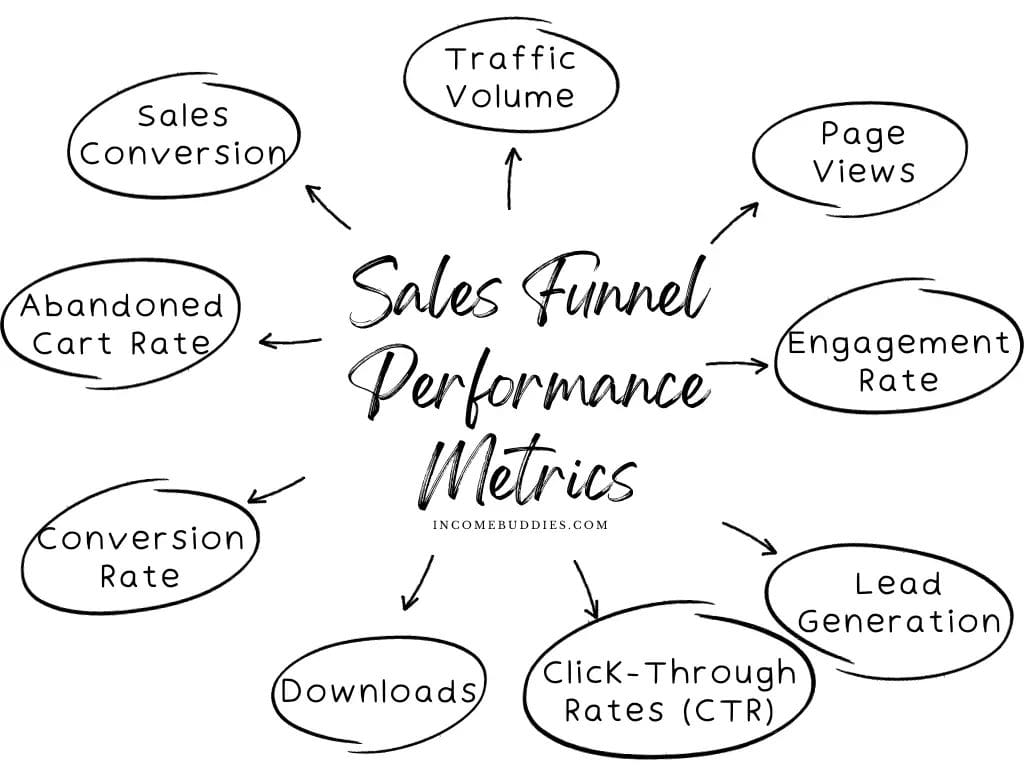
To truly understand the effectiveness of your sales funnel, you must measure its success and enhance its performance through targeted strategies.
Analyzing Sales Funnel Metrics
Your sales funnel’s success hinges on key metrics.
Track conversion rates at each stage, noting customer drop-off points.
Analyze your customer acquisition cost (CAC) against the lifetime value (LTV) of your customers to ensure sustainable growth.
Identifying and Repairing Funnel Leaks
Leaks in the sales funnel can drain your resources and impede conversions.
Identify drop-off stages by examining your funnel analytics. Then, investigate causes:
- Are your landing pages underperforming?
- Is your call-to-action unclear?
Repair these leaks by streamlining the sales process and strengthening your messaging.
A/B Testing for Funnel Optimization
Optimize your sales funnel with A/B testing.
Test and compare different versions of webpages, emails, and calls-to-action.
Use data-driven insights to decide which variant best guides potential customers towards a purchase, refining your sales strategy for better conversion rates.
Creating The Right Sales Funnel For Your Business
Your sales and marketing efforts must be aligned to smoothly guide your prospects through the funnel.
A well-structured funnel let you create a synergy that ensures you’re delivering the right message at the right time, converting leads into customers.
- Create a more specific sales funnel to identify high quality leads to increase your conversion rate.
- Create a sales funnel that is time and presented to at the exact moment where the buying intent is high offers higher level of conversion rate.
- Create a more detailed sales funnel that combines with various marketing strategy for higher value sales for products or service that is over $1,000.
Each stage of a traditional sales funnel is crucial, from gaining interest to closing a deal, making the funnel a key component in your digital marketing strategy.
Read Also:
- 7 Best Teachable Alternative for Course Creators (Free and Paid)
- LearnWorlds Features: In-Depth eLearning LMS Overview
- ThinkiFic Features: Course Creator’s In-Depth Overview
- +59 Best Proven Membership Site Ideas to Get Started This Year (Read First)
- Passion.io Review 2024: Still The Best App For Coaches & Creators? (Limited Time Lifetime Deal)
Join 900+ BUDDIES who are growing their wealth with our weekly Income Newsletter
Antony C. is a dividend investor with over 15+ years of investing experience. He’s also the book author of “Start Small, Dream Big“, certified PMP® holder and founder of IncomeBuddies.com (IB). At IB, he share his personal journey and expertise on growing passive income through dividend investing and building online business. Antony has been featured in global news outlet including Yahoo Finance, Nasdaq and Non Fiction Author Association (NFAA).

